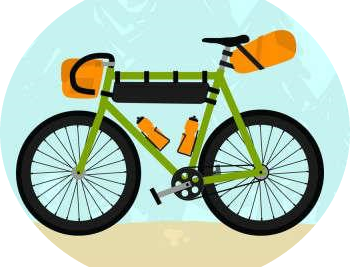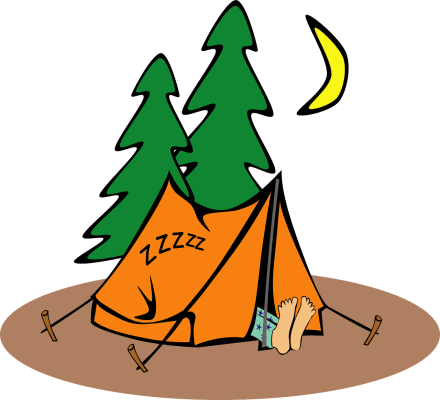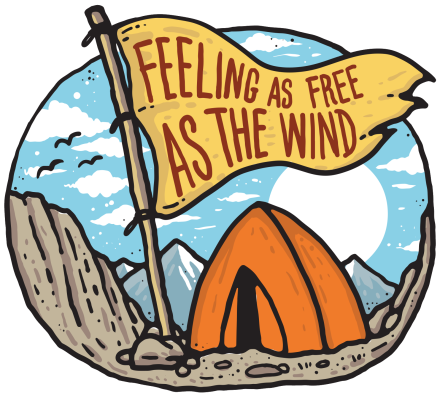Why bother camping?
I thought the same, but I discovered something new, though I just couldn't put my finger on it. I suppose one appreciates the quality of things we take for granted. After a ride, thirst made most drinks taste like nectar. When I was ready to eat, mild food tasted exquisite. Finally, when I came home I valued the roof over my head, and yet being home lacked something; the views, new experiences, and meeting new people. It goes around in a restless circle of yearning, but its clear simple pleasures bring the most joy.
Squeezing a fat man into a kids tent is very funny!
 I enjoy the high life and when it comes to food and accommodation, I’m a bit of a snob.
To keep the costs down on my cycle jaunts, a colleague in work suggested we try camping, carrying all the kit I
needed on the bike. At first I dismissed the idea, but then, maybe, why not? I’ll give it a try, if
I don’t like it I could always sell everything.
I enjoy the high life and when it comes to food and accommodation, I’m a bit of a snob.
To keep the costs down on my cycle jaunts, a colleague in work suggested we try camping, carrying all the kit I
needed on the bike. At first I dismissed the idea, but then, maybe, why not? I’ll give it a try, if
I don’t like it I could always sell everything.
I coerced my cycling comrade into giving it a try too, but he didn't know all I could borrow for him was a small kids tent. So off we went to camp near the idyllic and beautiful Goodrich castle on the River Wye. As night drew down on us, I exposed his tent, and after a few gamy words, I managed to shoe-horn him into the tent. When morning came it was clear the mythical scenery wasn’t enough to calm his soul. He dismissed the notion of ever sleeping on grass again (in fairness the tent was too small, but it was also hilarious). He threatened me with violence every time I laughed, but every time he moaned about another ache or pain from the uncomfortable nights sleep, I laughed.
I decided to persevere, and originally opted for
the most lightweight equipment available (which tended to be the most expensive too). The sleeping bag was duck
down and weighed four pounds, it was way too small (for a portly chap), and even in warm summer temperatures, I
was bloody freezing. Bit by bit, I discarded the lightweight stuff in favour of comfort; it was
cheaper, but heavier. Most camping blogs will categorise and give an account of how to save every ounce on the kit, but honestly, it doesn’t matter, you're not carrying the weight- the bike is! The stuff you take is relative, it’s all in the planning, but you don’t have to compromise if you don't want to. It just equates to a slower ride and with the right gears, you might not even notice a kilo or two more. So here it is; a summary of the kit I use to go cycle camping. Just click any of the of the icons below to go to that subject, or click any of the highlighted words to see a corresponding image or look out for the  sign for some little 'tidbits'.
sign for some little 'tidbits'.
What about the bike?
 It’s a Trek hybrid ready for adventure and hung off a reliable Reynolds 725 steel frame. With the added weight stopping safely is fundamental and in my opinion disc brakes are the best option, I even upgraded my rear brake to a hydraulic disc brake.
It’s a Trek hybrid ready for adventure and hung off a reliable Reynolds 725 steel frame. With the added weight stopping safely is fundamental and in my opinion disc brakes are the best option, I even upgraded my rear brake to a hydraulic disc brake.
Maintenance of the bike is critical, and the downfall of the disc brake system is they take a lot of fettling, the pads need to be adjusted and replaced on a regular basis. If you’re not comfortable doing this, then maybe 'V-brakes' would be better for you. The bike rolls along on a tough 36 spoke rear wheel and 32 spoke front, contact with the road is supported by 700x35c Schwalbe Marathon puncher-proof tyres  lined with puncher-proof tape making the tyre virtually indestructible.
lined with puncher-proof tape making the tyre virtually indestructible.
An extremely important part of a touring bike is the saddle, I’ve tried so many over the years, it’s been quite costly. In the end I settled for a Brooks leather saddle and I’d advise anyone to cut out looking for the right sadlle and just get a Brooks. It features delicately hand skived lower sides, where a thin stripe of the leather top surface is cut back, thus exposing the lighter coloured suede beneath which makes for an attractive visual accent and greater comfort when pedalling.
What about the panniers?
The rear pannier rack is a Madison bought on Ebay, the front rack is an adjustable Ostand Alloy from ‘Practical cycles’. Each bike will have different characteristics so it’s best to ask your local cycle dealer what rack will fit your bike.
Panniers can cost the earth, the expensive ones are Ortlieb and can be
hundreds of pounds, but I went for the cheapest ones I could get from Ebay (after all, at first I was just
trying it out). They were Pedalpro double panniers, but I believe ‘ETC’ do a similar one,
both around £10. Once they’re on, they’re on, but they enable me to strap the tent over
the top.  I bought some ‘SmartStraps’ (bungee toggles) to replace the Velcro, this offers the fixings a little more
give on rough ground.
I bought some ‘SmartStraps’ (bungee toggles) to replace the Velcro, this offers the fixings a little more
give on rough ground.
Are they waterproof? Mine are water resistant, but with some adjustments, they become as waterproof as they're going to be. I bought some cheap rucksack covers to help to repel the water. They were expensive, now you can pick one up
 for a fiver (Lumopod, Yoko, BTR), there are loads available (click the image to
see one).
for a fiver (Lumopod, Yoko, BTR), there are loads available (click the image to
see one).  Pack your items inside carrier bags within the panniers- 'belt and braces'.
The internal capacity may be a big factor, these are quite small, but big enough for a week’s trip. Remember the larger the
capacity, the more stuff you’ll carry and the more weight.
Pack your items inside carrier bags within the panniers- 'belt and braces'.
The internal capacity may be a big factor, these are quite small, but big enough for a week’s trip. Remember the larger the
capacity, the more stuff you’ll carry and the more weight.
Now you need lights (though most Bristolian cyclists think they don’t need any!)
There’s lights to be seen and lights to see where you’re going. To be seen- In a well lit urban environment a front and rear basic flashing light is suitable. You can’t go wrong with ‘Cateye’, though they’re expensive. The only cheap ones I’d buy are 'Smart' or ‘Torch’ front and rear (good back up lamps), they're lightweight and use two AAA batteries.
The simple fact of the matter is- you shouldn’t need lights in the daytime, but having them is only going to raise your chances of being seen and not becoming part of the street furniture. Specialist daytime rear lights
 are incredibly bright and I believe motorists do react favourably to them, it’s like a flashing pelican crossing lamp, they remind drivers there’s a hazard ahead. My rear day light is from
'C&Bseen' and connects to the same rechargeable battery as the front.
are incredibly bright and I believe motorists do react favourably to them, it’s like a flashing pelican crossing lamp, they remind drivers there’s a hazard ahead. My rear day light is from
'C&Bseen' and connects to the same rechargeable battery as the front.
To see where I'm going- I have a ‘Cree’ headlight, you can use this in the day, or in town at night (using the dimmer brightness setting), or what they're designed for; off road at night. The Cree front headlamp is bright as a car headlight, so you may have to physically dip these these on country roads to prevent blinding the oncoming motorist. There are so many good ones around these days, it’s worth exploring, but do get a good set of bright lights (in case you come unstuck and have to ride in the dark).
How about lighting the tent. You could use your bike lamps or a head torch to illuminate the tent, but I think this little LED lamp is brilliant, it's only about ½ the size of a small water bottle, retailing around £3; you can't go wrong. It turns down to a very dim light or up to a bright light.
Are we going in the right direction?
 In an age where high tech seems to rule the day, you may be old school and prefer paper maps. I’m sure it’s great fun joining all the bits together using sellotape and a pritt stick, then seeing a long route emerge from a pile of paper. However, I feel paper maps are expensive, heavy, and awkward to use on the bike, but don’t rule them out to plan a trip. You can’t expand a laptop over the dinner table to
In an age where high tech seems to rule the day, you may be old school and prefer paper maps. I’m sure it’s great fun joining all the bits together using sellotape and a pritt stick, then seeing a long route emerge from a pile of paper. However, I feel paper maps are expensive, heavy, and awkward to use on the bike, but don’t rule them out to plan a trip. You can’t expand a laptop over the dinner table to  see the whole weeks routes and highlight them with a marker. Once you’ve decided where you’re going to go, it’s almost impossible to ignore an electronic version of the route. You could use a smart phone map app, but it will use loads of battery on all day. Consider getting a specific cycle sat nav, I have a
Garmin Edge 605 as a specific
cycle 'sat nav'. Using this, you can actually plot your chosen routes, not just relying on
the road and the battery lasts days.
see the whole weeks routes and highlight them with a marker. Once you’ve decided where you’re going to go, it’s almost impossible to ignore an electronic version of the route. You could use a smart phone map app, but it will use loads of battery on all day. Consider getting a specific cycle sat nav, I have a
Garmin Edge 605 as a specific
cycle 'sat nav'. Using this, you can actually plot your chosen routes, not just relying on
the road and the battery lasts days.
Security is still important

You'll need a lock, there's loads available
and some are pricey. You have to come to terms with it; if someone wants your bike they'll have it,
but even  a cheap lock
stops the opportunist thief. I recently bought a Steerer tube GPRS tracker device for the bike, and
I just transfer it to whichever bike I'm using. I’m overwhelmed by
this gadget, it’s like having a virtual person sat next to your bike 24 hours a day. Have a look
at the gadget page to see it.
For a little extra peice of mind I bought a
Gallob bike alarm. They're no good if you're inside
a building and the bike is outside, but if you're inside a tent yards away from your bike; they're
great, they go for under a fiver on Ebay. Call me paranoid but I have cameras, back
and front. ‘GoPro’ are the market leaders in sports cameras, but I feel they’re too large and bulky. I use a
Mini-HDVR, brand new they’re
£150, but you can pick them up on Ebay quite cheap, I bought both sets for
under £60. Out of sight is out of mind and a Bike parker cover fits the bill, it also makes
life easier; I can leave the panniers and the cameras on the bike, kept dry and away from prying eyes.
a cheap lock
stops the opportunist thief. I recently bought a Steerer tube GPRS tracker device for the bike, and
I just transfer it to whichever bike I'm using. I’m overwhelmed by
this gadget, it’s like having a virtual person sat next to your bike 24 hours a day. Have a look
at the gadget page to see it.
For a little extra peice of mind I bought a
Gallob bike alarm. They're no good if you're inside
a building and the bike is outside, but if you're inside a tent yards away from your bike; they're
great, they go for under a fiver on Ebay. Call me paranoid but I have cameras, back
and front. ‘GoPro’ are the market leaders in sports cameras, but I feel they’re too large and bulky. I use a
Mini-HDVR, brand new they’re
£150, but you can pick them up on Ebay quite cheap, I bought both sets for
under £60. Out of sight is out of mind and a Bike parker cover fits the bill, it also makes
life easier; I can leave the panniers and the cameras on the bike, kept dry and away from prying eyes.
Now the sleepy bit
The tent; I can’t stress enough- do your research and see if you can actually fit in
it, decide if you want to sit in it when it’s raining. GoOutdoors usually have every tent set up, or
visit a camping show where the tents are all set up and get inside the
one you are considering. Even if you have no intention of buying, choose the one you want and buy
the tent second hand. Generally, one man tents are for leprechauns, and some two man tents
aren’t that much bigger either. I use the 'Vango Banshee 200' two man tent, it’s just about big enough for me.
The Banchee has an integral second skin bug net which can be detached if you just want a single skin.
 Buy the groundsheet to go with it, it
gives an extra layer beneath you and expands the footprint to store your stuff. My Vango has
survived torrential downpours with not a drop inside, it is a good tent, but I wish I’d bought
the Banshee 300.
Buy the groundsheet to go with it, it
gives an extra layer beneath you and expands the footprint to store your stuff. My Vango has
survived torrential downpours with not a drop inside, it is a good tent, but I wish I’d bought
the Banshee 300.

Most sleeping bags are designed for skinny bearded people (the beard is
non-obligatory), but I can’t stand being
tied up (they don’t call them 'mummy' sleeping bags for nothing). My sleeping bag is the
XL Urban Escape Garda Envelope Sleeping Bag from
Halfords, it’s massive and in respect to some others it's heavy, but it’s warm.  Filling the
space up with your spare clothes prevents cold spots.
Filling the
space up with your spare clothes prevents cold spots.
Now for the bed;
Lots of sensible animals make their own soft beds to sleep on, only humans are dumb enough to sleep on
a 5mm piece of foam? I’ve tried camp beds and roll mats and honestly, I'd rather sleep
on a corrugated roof. I even had a Skandika self
inflating mattress, that wasn't bad, but it was too wide for the bike
(restricting access through train doors). What I’ve settled on is the
Outwell Reel Airbed, it’s around £25 which is excellent value,
and it's really good ( don’t buy a cheap flock one, they’re heavier and
poor quality, often leaking frequently). The horizontal channels of the bed ensure even weight distribution
that delivers stability and night-long comfort. They can puncture, but can easily be repaired with the
don’t buy a cheap flock one, they’re heavier and
poor quality, often leaking frequently). The horizontal channels of the bed ensure even weight distribution
that delivers stability and night-long comfort. They can puncture, but can easily be repaired with the
 Outwell repair kit, that only costs £3.
Outwell repair kit, that only costs £3.
I use the 'Runacc' Electric Air
Pump. It's about the size of a tea mug and weighs around the same. It’s integral battery lasts a
about an hour, easily enough to pump up dozens of camp beds (so it should last a week without
recharge). I used to use the NeoAir pump, tiniest on the market, but it’s basicaly over-priced crap.
 What about a pillow? There are loads out there, mine is the
self-inflating type from one of those cheap shops and cost a couple of quid.
What about a pillow? There are loads out there, mine is the
self-inflating type from one of those cheap shops and cost a couple of quid.
Cooking
I started off with a Ghillie kettle, they’re good, but when you're soaking wet desperately needing a rapid
brew. It's likely the fuel's wet too, then, it's a pain in the butt because you will not be able light it. So, I choose a small
Vango remote camping stove. You'll need a shield
and pots, my pots were £8.58 on Ebay, the little Vango stove conveniently fits inside the
 pots. It’s a must to have a table to rest that cocktail and the grub. This lightweight
stick table is from
GoOutdoors at around £6.
pots. It’s a must to have a table to rest that cocktail and the grub. This lightweight
stick table is from
GoOutdoors at around £6.
You can either sit on the grass or find
somewhere to sit, I bought a host of chairs and found them all unsuitable for me except one; the
Helinox chair. It's a super-lightweight, compact
and the most comfortable backpacking chair that you can carry anywhere. It’s a bit pricey
at around £80, but it’s worth it. On the downside the feet can dig into
soft ground, but  tennis balls placed on each foot
will prevent them digging in.
tennis balls placed on each foot
will prevent them digging in.
Bike extras
A pump is essential, but believe me, buy a cheap one and you’ll regret it first puncher. I use
the Topeak's mini G, the handle turns at ninety degrees
and there’s a foot hold, they’re expensive around £28. I'm testing the Tiakia aluminium bike pump
and as with other stuff, I'll let you know. Some of the newer ones have the ability
to fit the CO2 gas cyclinders. To go with it you’ll need a spare inner tube and levers,
Continental put one in a small bag for under a tenner,
 it fits under the saddle for easy access.
For somewhere to store your knick knacks and the Mini-HDVR
recorders, I use a small crossbar bag (there’s loads available), mines from
Roswheel Last accessory is a little bell, you can pick them
up from Ebay for £1.
it fits under the saddle for easy access.
For somewhere to store your knick knacks and the Mini-HDVR
recorders, I use a small crossbar bag (there’s loads available), mines from
Roswheel Last accessory is a little bell, you can pick them
up from Ebay for £1.
And the rest (nice to have)
I like to get close to nature, but I like my creature comforts too. There's a great mp3/ radio
that fits snug on the bars, called 'Sport music'. It doubles up as a speaker if you wish to play your smart
phone music. The instructions aren’t clear and it's a bit fiddly to use, but persevere, they’re brilliant.
I bought a  PortaPow
solar powered USB charger from Amazon for £36.
It’s expensive, but superb and folds up like a small book. I can charge anything that needs a USB charger, I can
even charge stuff on the go.
PortaPow
solar powered USB charger from Amazon for £36.
It’s expensive, but superb and folds up like a small book. I can charge anything that needs a USB charger, I can
even charge stuff on the go.  If you’re going to get a small solar panel (the same size as a phone),
don’t bother, they don’t work (I’ve tried them). This item may be well over the top, but
it’s supposed to keep little beasties at bay (rats,
mice, spiders); does it work? I’m not sure, but I’ve never had any issues with the battery
powered ultrasonic pest repellent. I’ve a few more nick-nacks and hopefully they’re covered in the following list.
If you’re going to get a small solar panel (the same size as a phone),
don’t bother, they don’t work (I’ve tried them). This item may be well over the top, but
it’s supposed to keep little beasties at bay (rats,
mice, spiders); does it work? I’m not sure, but I’ve never had any issues with the battery
powered ultrasonic pest repellent. I’ve a few more nick-nacks and hopefully they’re covered in the following list.
Here's a comprehensive list of stuff (it's quite alot)
- Bicycle Accessories (mounted to bike)
- Front & Rear Rack & Panniers (with rain Covers).
- Seat/ Frame Bag.
- Water Bottles + Cages & Hydration Pack.
- Polar M460 Heart monitor (with charger lead).
- LED Flashing Tail Light (and or rear daylight lamp).
- LED Head Light (and or cree headlamp).
- Front & Rear mudguards.
- Bungie Cords.
- Garmin edge 605 (with charger lead).
- Sport radio/ mp3 player.
- Bike Lock/ alarm (key or combo cable is sufficient, U-Locks are heavy but excellent).
- Camping Gear
- Tent (poles, stakes, tent Patch Kit, ground sheet).
- Sleeping Bag (in sealed polythene bag) & Compression Sack.
- Sleeping Bag Liner (for mild/cold camping or hostel use).
- Air Mattress (Patches and blower).
- Air Pillow (or use extra clothes in stuff sack).
- Backpacking Stove (in stuff bag or cook pot) & gas.
- Utensils: Travel Mug, Spork.
- Chemical Water Purifier
- Water Tank (on my mountain bike)
- Portable Camp Chair & table.
- Bike Cover.
- Cycling Clothes (weather dependant)
- Helmet (proper size & fit) & glasses.
- Base layers (merino or synthetic).
- Cycling Jersey (long sleeve or short)
- Cycling Shorts (2 pairs maybe 3 for long tours).
- Cycling Gloves.
- Cycling Socks (Synthetic / Wool; 2-3 pr. i.e. Coolmax).
- Clipless Cycling Shoes.
- Foul-Weather Cycling Clothes
- Long-Sleeve Jersey / Light-Mid Synthetic/Wool Zip Shirt.
- Cycling Long-Tights (roubaix).
- Rain Jacket/ Cape (waterproof nylon / Gore-Tex ).
- Fall/ Winter Gloves.
- Helmet Liner / Skull Cap / Fleece or Wool Hat.
- Waterproof Socks (i.e. Sealskinz/ Gore-Tex )
- Waterproof Rain Booties/ Gaiters.
- Helmet Cover (shower cap)
- Camp + Town Clothes (in nylon stuff sack)
- Cotton T-Shirt / Collared Travel Shirt.
- Fleece Jacket/Vest or Pullover.
- Synthetic trousers.
- Underwear.
- Flip-Flops/ Running Shoes.
- Food Bag (in zip-lock bags inside nylon stuff sack)
- Meals & Snacks
- Sports/ Energy Drink Mixes (i.e. zipfit powder).
- Personal Items
- Credit Card(s)/ money.
- Sunglasses (case; extra lenses; neck strap; cleaning cloth).
- Sunscreen (SPF 30+; sweatproof; spray is more convenient).
- Insect Repellent (25% DEET or alternative).
- Lip Balm (i.e. Chapstick / Blistex).
- Mobile Phone & Charger lead.
- Digital Camera; Memory Cards; Charger; Case (+ accessories).
- iPod / mp3 Player (Radio; Recorder + Earphones; Charger).
- Maps.
- Tablet/ iPad.
- Solar panel
- Bike Tools + Spare Parts
- Air Pump/ Co2 cylinders.
- Patch Kit & Tyre Levers.
- Spare Tubes.
- Presta/ Schrader Valve Adapter.
- Chain oil & chain splitter.
- Spokes & key.
- Bicycle Multi-Tool (i.e. Topeak Alien II ).
- Duct Tape.
- Plastic Zip Ties (various sizes)
- Leather saddle cover (they don't like wet weather).
- Toiletries (in polar watch carry bag)
- Travel Towel (i.e. MSR Pack/Towl or chamois)
- Soap/ Shampoo (In tiny bottles)
- Deodorant (travel size)
- Toothbrush & Toothpaste
- Some Handy/Baby Wipes
- Disposible Razor (shaving cream)
- Ear Plugs (for sound sleeping in woods, hostels, etc.)
- Prescription Medication
- Moleskin/ Blister Bandages
- Alcohol Wipes
- Ibroprophen/ Paracetamol
- Anti-Chafing Balm/ nappy rash cream (for saddle sores)
- Anti-Diahearreal Tabs (i.e. Imodium)
- Antihistimine Tablets (i.e. Benadryl )
Wild camping
When it comes to wild camping, my experience is very limited. So, I’ve researched some great sites that will tell you everything you need to know. From what I can gather; wild camping in England and Wales and Northern Ireland is illegal except in some parts of Dartmoor. And when I say illegal, currently (2020) for one or two people, it’s a civil offence not criminal (except some MOD or Government restricted land). So, if you arrive late and depart early, making sure you're unobtrusive, you’ve not left anything (except burying your biodegradable waste), or damaged anything- what harm have you done? And you're unlikely to to be confronted. If
 you do get challenged by the landowner, apologise and maybe offer to pay, or complement the person how beautiful the spot is, suggest you will move on, pack your stuff up and go. The ‘get around clause’ is to get the landowners permission, if you can do this, it isn’t illegal, so you could just ask!
you do get challenged by the landowner, apologise and maybe offer to pay, or complement the person how beautiful the spot is, suggest you will move on, pack your stuff up and go. The ‘get around clause’ is to get the landowners permission, if you can do this, it isn’t illegal, so you could just ask!
It’s interesting to point out this doesn’t include bothies, these are basic shelters, usually left unlocked and available for anyone to use free of charge and found in remote areas in the UK. The Mountain Bothies Association website have some some great articles and a comprehensive list of where they are, don’t be put off by the word ‘mountain’, some of the bothies are near the coast. To read about the time when my chum and I stayed in a Welsh bothy, click here. The 'halfway house' to dip your toes into wild camping is on nearly wild sites, this is where the landowner has realised the potential of allowing people to camp on their land, but haven’t commercialised the plot. That means; no toilets, no showers, no shops or pubs, and best of all (if you’re lucky); no people. One website I’ve found that highlights some great nearly wild camp sites is 'coolcamping.com'. It lists 49 sites around the UK that have been tried, tested, and rated, it’s certainly inspired me to give some a go.
Wild camping in Scotland
 Scotland allows wild camping on most unenclosed land. This excludes private residential or public property (such as school grounds or playing fields), golf courses or other visitor attractions, airfields, working sites (such as quarries), military bases or land with crops growing. That said; you’re spoilt for choice in Scotland. On the Western Isles you’re never far from water and the idyllic scenery. Inland, the rolling moorland offers almost unlimited (if rather boggy) choice for those with a more adventurous spirit, as well as miles of woodland and forest to explore. 'Red Bull' sponsor everything from formula one to every cycling subdivision going, they also have great interesting websites. Here is one that explores 'Scotland’s top ten wild camping spots'.
Scotland allows wild camping on most unenclosed land. This excludes private residential or public property (such as school grounds or playing fields), golf courses or other visitor attractions, airfields, working sites (such as quarries), military bases or land with crops growing. That said; you’re spoilt for choice in Scotland. On the Western Isles you’re never far from water and the idyllic scenery. Inland, the rolling moorland offers almost unlimited (if rather boggy) choice for those with a more adventurous spirit, as well as miles of woodland and forest to explore. 'Red Bull' sponsor everything from formula one to every cycling subdivision going, they also have great interesting websites. Here is one that explores 'Scotland’s top ten wild camping spots'.
The rest of Europe
Ireland, France, Spain, Portugal and eastern Europe have similar rules to England and Wales: you cannot camp on private land unless you have the express permission of the local landowner. In Italy and Germany, they don’t have a wild camping culture and it’s not widely tolerated. The ‘Rough guide’ group have always been useful when doing any kind of travel and they have some good information for the top 15 places to wild camp in the world. You may be interested to find out two of the places listed as the best in the world- are in the UK.
Top Tips!
- If you're new to cycle touring or if you have a new piece of kit, it’s important to go for a 'dry run' before you embark on a tour. A short overnight trip not to far from home will help sort out any problems or shortfalls in the equipment. The last thing you need is to be burdened with a piece of kit that doesn't reach your expectations.
- Many people do short journeys with a rucksack, but I can assure you it’s horrendous carrying anything on your back for anything longer than an hours ride. If you find yourself needing to carry a rucksack then you’re probably carrying too much gear.
- It’s important to have a backup plan, if you’re just going to ride until you’re tired then stop, you still need a backup. Consider your fluid and food, will it last to the next place to refuel? Sometimes a route may be closed sending you on a massive diversion, this happened to me on a ride.
 Screw-top type gas canisters are not readily available in mainland Europe, so either use the pierce type gas canister stove, or carry sufficient gas to last for the duration of your stay. Bear in-mind there are restrictions applying to the carriage of gas on ferries and especially on the Euro-tunnel. You may have to consider getting a multi-fuel stove (like an Optimus Nova multi-fuel stove around £120), the fuel is cheap and readily available in most countries.
Screw-top type gas canisters are not readily available in mainland Europe, so either use the pierce type gas canister stove, or carry sufficient gas to last for the duration of your stay. Bear in-mind there are restrictions applying to the carriage of gas on ferries and especially on the Euro-tunnel. You may have to consider getting a multi-fuel stove (like an Optimus Nova multi-fuel stove around £120), the fuel is cheap and readily available in most countries.- I can endorse using both front and rear panniers, but consider packing each pannier with an equal weight of gear on both sides to increase stability. Then distribute the weight 40/60(rear). If you load everything on just a rear rack the stability of the bike can be compromised causing a 'wallowing' effect when turning at speed.
- Pack your stuff in order with a thought to what needs to be readily accessible on route. My waterproof coat is separately packed in a neoprene pull string bag attached under the saddle. My glasses case is also attached to the outside of the panniers to interchange between clear or shaded glasses without rummaging through the panniers. My tool-kit and spare inner-tubes are easily available, always packed on the right hand side of the panniers in the small pocket.
- Pack everything in waterproof bags, most panniers are not waterproof. Practise putting things back into bags after use, sleeping bags are especially tricky getting them back into their stuff sack and then a waterproof bag. I use the vacuum-pack bags, they come in various sizes and you use your mouth to suck the air out, making their profile smaller and completely dry.
-
 Carry plenty of drink (particularly when it is hot). In some countries or remote areas, there can be quite a distance between shops or places to obtain potable water. You could take a
water purification kit, some don’t weigh that much at all.
Carry plenty of drink (particularly when it is hot). In some countries or remote areas, there can be quite a distance between shops or places to obtain potable water. You could take a
water purification kit, some don’t weigh that much at all. - The batteries for your gadgets can sometimes be an issue, AA batteries are the easiest to get hold of in most countries. You may have to carry a stock of AAA batteries and definitely spare button batteries.
- Don’t neglect a first aid kit, again depending on where you’re going, you may need to take loads of stuff or very little dependant on the country you’re visiting. In Scotland I needed antihistamine cream and had the luxury of attending the health centre when it opened the next day, in a remote area you may not be so lucky. It’s important to be aware of ticks and learn how to remove them, unfortunately some ticks can potentially carry several nasty diseases such as Lyme Disease or Tick-borne encephalitis.
You've got to give it try!
 It has become something of a compulsion for me to get away from work and home to de-stress at least once a month.
It has become something of a compulsion for me to get away from work and home to de-stress at least once a month.
Camping began out of necessity in order reduce the overall cost of the cycling trips, but it really did open up new horizons. It unexpectedly provided a perfect opportunity to clear my mind from everyday clutter. Living in a city, our brains process millions of bits of information, most of it superfluous, and just everyday hassle. Getting away from the ‘rat race’ allows us to ‘put the mental trash out’ resetting to a primal input. An added bonus of camping is it allows you to connect to nature, you can smell nature and touch it, encountering wildlife you’d never see in an urban area. With no pollution, the sky is clearer and the stars are definitely brighter. Under my duvet at home, it’s always too warm and cosy to crawl out of any earlier than I need to. With all the data input reduction, the dawn chorus often wakes me up, then I can just unzip my tent and watch the sunrise from the comfort of my toastie sleeping bag, then fall back into a deep sleep.
Remember it's a Holiday!
It’s too easy to get caught up in doing miles for miles sake. If you aren't careful it’s possible to cycle too far in a day or try and fit too much into the time you have available. The ride will become a slog, an endurance test and you’ll end up staring at the tarmac for most of the day and not enjoying the ride itself! I was guilty of this when I did the ‘Waverley ride’, many times I’ve had to prod myself into believing I was enjoying it. The answer- slow down, immerse yourself in the moment, and lift your head up to see the views around you. Experience now dictates my mileage, if it’s mountainous terrain (on the road) my miles are reduced to around 25 miles for the day, if it’s off road; it’s a maximum of 30 miles for the day. Purely on the road it's 40 miles a day (with a stretch to 50 or 60 miles on an absolutely flat route). The mileages are achievable and are predetermined in the planning, but of course; these distances can be disrupted by bad weather or mechanical problems, but the beauty about camping is, it doesn't matter where you stop.
 I can sleep in comfort, warm and dry. I can sit in comfort (if it’s dry) and read my books on my iPad (knowing I won’t run
out of battery) or I can listen to the radio or play songs, I can cook or make tea, I can lock the bike
up and cover it. Once you've shelled out for the initial outlay, camping works out at a fraction of
the cost of staying in a hotel. It doesn’t compete with a night in a hotel, that’s good too, camping is just a different experience. I’ll re-quote a sentence from the N Wales ride- "I opened the outer flap of my tent and
saw lightening striking the mountain range in the distance. I lay there for quite some time marvelling at
this free show, I’ve never seen anything quite like it, it was fantastic."
I can sleep in comfort, warm and dry. I can sit in comfort (if it’s dry) and read my books on my iPad (knowing I won’t run
out of battery) or I can listen to the radio or play songs, I can cook or make tea, I can lock the bike
up and cover it. Once you've shelled out for the initial outlay, camping works out at a fraction of
the cost of staying in a hotel. It doesn’t compete with a night in a hotel, that’s good too, camping is just a different experience. I’ll re-quote a sentence from the N Wales ride- "I opened the outer flap of my tent and
saw lightening striking the mountain range in the distance. I lay there for quite some time marvelling at
this free show, I’ve never seen anything quite like it, it was fantastic."
Honestly- why wouldn’t you give it a go.














